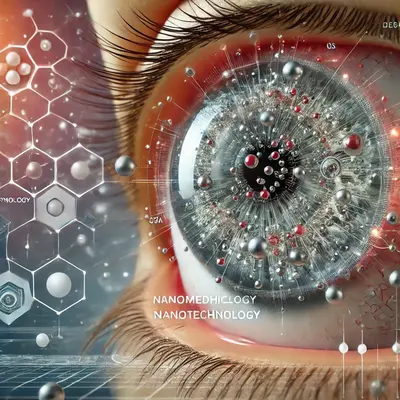Nanotechnology has been making waves in various fields of medicine, but its application in ophthalmology is one of the most promising frontiers yet. This branch of nanomedicine offers a powerful, precise way to treat eye conditions that are often difficult to manage using traditional methods. As technology advances, we are beginning to see how nanotechnology might shape the future of eye care, providing hope for millions of individuals struggling with eye diseases and disorders.

Understanding Nanotechnology in Eye Care
Nanotechnology involves manipulating materials on an atomic or molecular scale—typically less than 100 nanometers in size. In ophthalmology, this means creating drugs or devices so small that they can easily interact with the delicate structures of the eye. Treatments that utilize nanotechnology can deliver medications more efficiently, target specific areas of the eye, and potentially minimize side effects.
For example, micro-particles are being developed to treat age-related macular degeneration (AMD), one of the leading causes of blindness worldwide. Unlike traditional methods that often require painful injections, nanoparticles can help deliver drugs directly to the affected tissues, offering a less invasive and more comfortable alternative for patients.
Innovative Applications of Nanotechnology in Ophthalmology
1. Targeted Drug Delivery for Glaucoma
Glaucoma is a leading cause of irreversible blindness. Traditional treatments often involve daily eye drops to lower intraocular pressure, but adherence can be challenging for many patients. Nanotechnology is helping to solve this problem through targeted drug delivery systems.
Scientists have developed nanoscale drug delivery particles that can adhere to the corneal surface and release medication gradually, ensuring that the right amount of the drug reaches the targeted tissue. Take Maria, for example—a 72-year-old who struggled with her eye-drop regimen. By using a nanoscale delivery system, she was able to receive sustained-release medication that kept her glaucoma in check, reducing the need for daily drops.
2. Nano Coatings for Cataract Lenses
Cataracts are one of the most common causes of vision loss, especially in older adults. Treatment generally involves replacing the clouded lens with an artificial one. Recently, researchers have begun developing nano coatings for these artificial lenses that can reduce postoperative complications such as infection and inflammation.
Consider Alan, a 65-year-old patient who underwent cataract surgery. With the use of nano-coated lenses, the risk of inflammation and bacterial infection post-surgery was significantly minimized. These advancements make the recovery process smoother and more predictable, allowing for better patient outcomes.
Challenges in Nanotechnology Adoption
While the possibilities of nanomedicine are astounding, challenges do remain. High production costs, regulatory hurdles, and the need for long-term studies on the effects of nanoparticles are areas that require attention. There is optimism, however, that as research progresses, these barriers can be overcome to make nanotechnology more accessible to everyone.
Nanotechnology and Age-Related Macular Degeneration (AMD)
Age-related macular degeneration (AMD) affects millions of people globally, and its treatment has always been challenging due to its progressive nature. Nanotechnology offers a beacon of hope for AMD patients. With the use of nanoparticle carriers, drugs can be precisely targeted to the retina, increasing efficacy and minimizing side effects.
Researchers at a leading eye care institute have quoted, “Nanoparticles enable us to administer drugs directly to the macula, allowing for targeted therapy that could significantly slow down vision loss” (Dr. Laura Thompson, National Eye Research Institute). Patients like Elise, who have been battling AMD for years, are now experiencing longer periods without disease progression, thanks to these advanced technologies.
The Potential of Nanorobotics in Eye Surgery
Imagine nanorobots so small they could work at a cellular level to repair retinal damage or help restore vision in individuals who are visually impaired. Although it may sound like science fiction, researchers are working on such applications today. These nanorobots could be injected into the eye to identify damaged cells and perform repairs without the need for invasive surgeries.
Future Prospects: Personalized Nanomedicine
The future of nanotechnology in eye care isn’t just about treating existing conditions—it’s also about preventing them. Personalized nanomedicine, tailored to a patient’s genetic makeup and specific health needs, is on the horizon. For instance, a patient with a genetic predisposition to glaucoma could receive a custom nanomedicine treatment designed to prevent the onset of the disease.
Dr. Samuel Rodriguez, a leading researcher, stated: “The integration of personalized nanomedicine can help us prevent eye diseases before they manifest. We’re moving towards an era of proactive eye care.”
Table: Current Applications of Nanotechnology in Ophthalmology
| Application | Description | Benefits |
|---|---|---|
| Targeted Drug Delivery | Nanoscale particles used to deliver drugs to specific eye tissues | Reduced side effects and improved efficacy |
| Nano Coatings for Artificial Lenses | Nano-coated lenses for cataract surgery | Decreased inflammation and infection risk |
| Nanorobotics in Surgery | Nanorobots for cell-level repair | Potential to restore vision in damaged retinas |
| Personalized Nanomedicine | Custom treatments based on genetics | Prevention of diseases and tailored care |
A Look at the Numbers
- 3 million Americans are affected by glaucoma annually, many of whom could benefit from nanotechnology solutions.
- 50% reduction in post-cataract complications has been observed with nano-coated lenses.
- $200 million invested in ophthalmic nanotechnology research globally in 2023 alone.
Expert Quote on Nanotechnology in Eye Care
According to Dr. Emily Chen, an expert in ophthalmology research, “The ability of nanotechnology to target specific cells within the eye is changing the landscape of how we treat ocular diseases. We’re not just improving treatment efficacy but also enhancing patients’ quality of life.”
The role of nanotechnology in ophthalmology is nothing short of revolutionary. It promises better treatments, fewer side effects, and more personalized approaches to eye care. Whether through targeted drug delivery, improved surgical materials, or futuristic nanorobots, nanotechnology is setting the foundation for a new era in vision health. As these innovations become more widespread, the hope is that millions more can retain or regain their sight, allowing for a richer quality of life.
The journey has only just begun, but the future is bright—and increasingly, it’s in the details that only nanotechnology can address.





